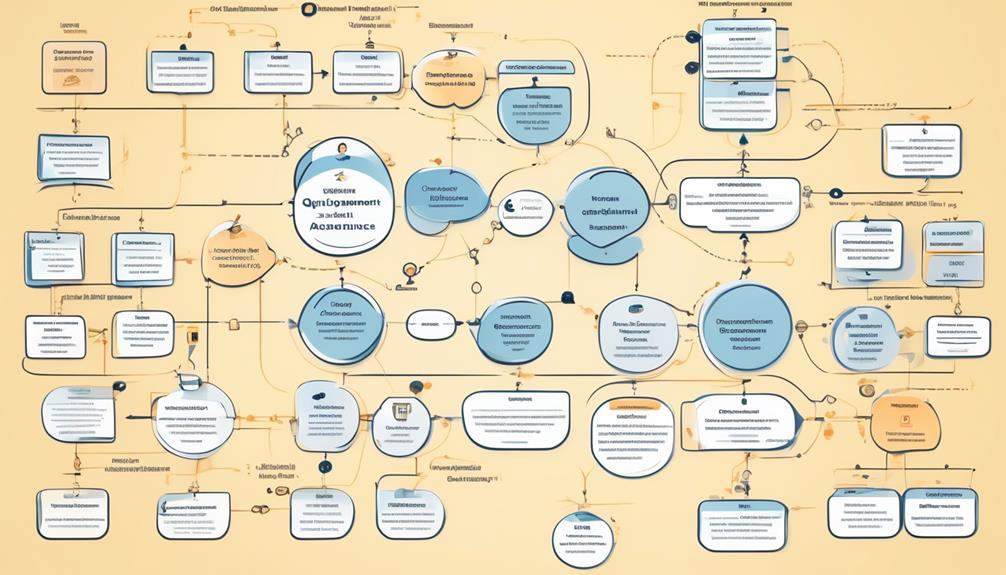When maneuvering through the complex realm of software development, quality assurance software acts as a dependable companion, assisting us in guaranteeing that the end product meets top-notch standards.
But what exactly does quality assurance software entail, and how does it impact the final outcome of our work?
Let’s explore the inner workings of this essential aspect of software development and uncover its significance in today’s technological landscape.
Key Takeaways
- Quality assurance software is essential for maintaining predetermined quality standards throughout the software development life cycle.
- It involves setting and adhering to quality standards, conducting measurements, and reviewing workflows.
- Quality assurance software ensures compliance with industry standards such as ISO/IEC 9126, SPICE, or CMMI.
- The key components and activities of quality assurance software include meticulous planning, software engineering techniques, formal technical reviews, and a comprehensive testing strategy.
Definition of Quality Assurance Software
We ensure that quality assurance software maintains the predetermined quality standards throughout the development life cycle.
Software Quality Assurance (SQA) is an integral part of the software development process, encompassing activities that aim to control and manage the quality of products. SQA involves setting and adhering to quality standards, conducting measurements, and reviewing workflows to continuously improve and maintain product quality.
It’s organized into goals, commitments, abilities, activities, measurements, verification, and validation, ensuring that high-quality specifications and designs are achieved at each phase of development. Quality assurance software is crucial for ensuring compliance with ISO/IEC 9126, SPICE, or CMMI standards.
It involves reviewing and auditing software products and activities to ensure they meet the specified quality criteria. By integrating testing and quality assurance throughout the development process, SQA ensures that the final product meets the highest quality standards.
This meticulous process not only ensures the quality of the end product but also supports the overall improvement of the software development process.
Key Components and Activities

Key components and activities of quality assurance software encompass:
- Meticulous Planning: Creating a comprehensive SQA plan to outline quality assurance activities, including setting checkpoints for regular quality inspections to evaluate project performance.
- Software Engineering Techniques: Deployment of software engineering techniques to ensure high-quality specifications and designs, thus laying the foundation for a robust and reliable end product.
- Formal Technical Reviews and Multi-Testing Strategy: Conducting formal technical reviews to evaluate design and quality, and implementing a multi-testing strategy to ensure comprehensive testing and identify potential issues at various stages of the development process.
These key components and activities are critical in the quality assurance process, as they ensure that the software meets the predetermined quality standards and the end product is reliable, robust, and of high quality. The meticulous planning, software engineering techniques, formal technical reviews, and multi-testing strategy collectively contribute to the overall quality assurance of the software product.
SQA Plan Techniques
In the pursuit of meticulous and methodical quality assurance, the implementation of SQA plan techniques plays a crucial role in ensuring the alignment with requirements, identification of responsibilities, and the execution of high-quality testing methodologies.
SQA plan techniques encompass various activities such as auditing, reviewing, code and design inspection, and simulation to ensure high-quality specifications and identify and eliminate errors.
The SQA Management Plan involves planning SQA activities, setting checkpoints for evaluation, measuring change impact, utilizing a multi-testing strategy, and maintaining good relations with other teams.
These techniques are crucial within the software development life cycle as they enable the QA team to uphold quality standards, perform continuous integration, and conduct effective code reviews.
Major SQA activities include planning, setting checkpoints, measuring change impact, employing a multi-testing strategy, managing relations, and documenting QA activities for future reference and stakeholder alignment.
Benefits of Quality Assurance Software

Quality assurance software is instrumental in ensuring the meticulous implementation of SQA plan techniques, as it brings about a myriad of benefits for software development teams and their clients.
The benefits of quality assurance software include:
- Enhancing Overall Product Quality: By assuring quality through continuous testing and QA activities, high-quality software products are delivered, meeting quality standards and client expectations.
- Reducing Headaches and Costs: Identifying and fixing product shortcomings before public release reduces headaches for the development team, minimizes customer dissatisfaction, and saves time and money by preventing costly errors and the need for fixes and upgrades.
- Improving Brand Reputation and Customer Satisfaction: Quality assurance software not only improves brand reputation and customer satisfaction but also attracts more customers, supports business growth, and cuts maintenance costs by getting the release right the first time.
Importance in Software Development
Vital to the success of software development, Software Quality Assurance (SQA) plays a critical role in preventing costly errors and upgrades and in boosting consumer confidence while maintaining the company’s competitive edge in the market. SQA is integral to ensuring that the software product meets industry standards and the requirements of the Development Life Cycle (SDLC). It encompasses the entire software process, including planning, coding, testing, and maintenance, to ensure compliance and enhance the overall quality of the software.
In software development, the importance of SQA can’t be overstated. It acts as a safeguard, identifying and rectifying defects early in the development cycle, thus saving time and preventing disruptions. By implementing rigorous testing and quality assurance measures, SQA contributes to the delivery of high-quality software products that meet customer expectations and adhere to industry standards. This not only reduces maintenance costs but also enhances customer satisfaction, improves brand reputation, and supports business growth and expansion.
Furthermore, SQA techniques such as auditing, code inspection, and simulation are essential for maintaining the integrity and quality of the software throughout its lifecycle. The meticulous attention to detail and the rigorous analytical approach of SQA ensure that software development processes are methodical and that the resulting products are of the highest quality.
Frequently Asked Questions
What Is Meant by Software Quality Assurance?
We ensure software quality through an ongoing process called Software Quality Assurance. This process runs parallel to software development, identifying and resolving quality issues in each phase. Its goal is to catch product shortcomings before they reach the public, covering more than just bad coding.
SQA differs from software testing as it not only finds errors but also solves them. This meticulous approach ensures that software meets established quality specifications.
What Is an Example of Quality Assurance in Software?
An example of quality assurance in software is conducting formal technical reviews to evaluate design and quality. This proactive approach ensures the software meets quality standards and client expectations, reducing headaches for the development team.
Another aspect of quality assurance is implementing a multi-testing strategy for comprehensive testing. This helps in identifying and fixing product shortcomings before public release, ultimately enhancing the overall product quality.
In addition, managing changes to ensure adequate practices are in place is an important part of quality assurance. By effectively managing changes, the development team can ensure that the software remains in line with quality standards.
What Are the 4 Types of Quality Assurance?
Certainly!
The four types of quality assurance are:
- Internal
- External
- Process
- Compliance
Each type plays a critical role in ensuring the quality and effectiveness of our organization’s processes and outputs. By focusing on maintaining and improving our processes, we can meet quality standards and adhere to relevant laws, regulations, and standards.
This comprehensive approach ensures that our products and services consistently meet high-quality standards.
What Is the Purpose of QA Software?
The purpose of QA software is to ensure software meets quality standards, reduces headaches for the development team, and fixes product shortcomings before public release.
It works parallel to software development, checking for quality issues in each phase and aims to catch product shortcomings before release.
QA software differs from software testing as it not only finds errors but also solves them, covering more than just bad coding.
It’s crucial for preventing costly errors, saving time, and maintaining good relations between QA and development teams.
Conclusion
In conclusion, quality assurance software plays a critical role in ensuring the reliability and quality of software products.
According to a recent study by Capgemini, implementing effective quality assurance processes can result in a 40% reduction in overall software development costs.
This statistic highlights the significant impact of quality assurance software on the efficiency and effectiveness of software development, making it an essential aspect of the development process.









